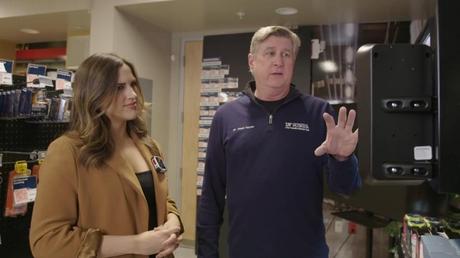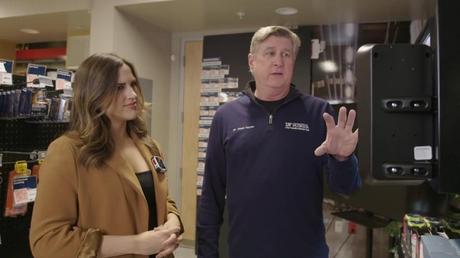Preventing shoplifting before it happens: it sounds like a fairy tale, but artificial intelligence can make it reality.
Videos and images of organized "smash-and-grabs"in stores and malls across the country have gone viral online, and some of the country's largest retailers are turning to technology to stem billions in losses and keep employees and customers safe.
And they do it together.
Companies from Target (TGT), Walmart (WMT) and Home Depot (HD) to Walgreens (WBA) and TJ Maxx (TJX) are collectively investing big bucks in AI, real-time heat maps and other improvements in an unprecedented effort to solve the problem of organized combat shoplifting.
"We're seeing a groundswell of collaboration," Mike Lamb, a former Kroger (KR) loss prevention manager, told Yahoo Finance for NEXT. "I see more of this collaboration than maybe ever in the 40-plus years I've been in this room."
Reduce is the word
In addition to the shocking images seen in news reports and social media, mentions of organized retail crime in retailer earnings calls increased 43% between January and August 2023, according to Yahoo Finance reporting.
The industry uses the term "shrink" to describe any impact on inventory, including shoplifting, employee theft, supplier fraud, damage, administrative errors and other causes. And it's a big problem: According to the National Retail Federation, a prominent lobbying group, losses from total contraction would be as much as $112 billion by 2022.
However, inadequate data makes it difficult to quantify how much organized retail theft is contributing to the decline. Last year, the National Retail Federation retracted a false claim it made in a 2021 report that attributed nearly half of the retail industry decline to organized retail crime.
The retail crime stories also became complicated when Walgreens CFO James Kehoe backtracked on his assessment of shoplifting, saying the retailer was "crying too much" about organized retail crime.
The story continues
In 2023 congressional testimony, Trevor Wagener, chief economist at the Computer & Communications Industry Association, gave a more moderate assessment, noting that organized retail crime is responsible for about 5% of total retail inventory losses, although that remains always amounts to billions. when losing.
Still, contraction was the buzzword for retailers last year, and that has continued to some extent during the most recent earnings season, with Target CEO Brian Cornell noting on the company's most recent earnings call that "contraction growth has a significant financial headwinds remain. "
Pack heat cards
That has led Target and other companies to do what would once have been unthinkable: collaborate with their direct competitors on high-tech solutions.
For example, with an AI-powered heat map, retailers can share real-time data with each other in the hopes of stopping large-scale smash-and-grab attacks before they happen, while protecting consumers and employees.
The heat map uses AI to predict future crime events by pulling data from as many sources as possible, from law enforcement to the retailers themselves. That data creates hotspots for potential criminal activity that participating businesses can see on the map's dashboard.
The longer-term goal is to equip participants with walkie-talkies and an app that calls when a crime occurs nearby, so stores can be prepared.
Finding the balance between preventing theft, reducing losses and protecting employees and customers is exactly why retailers are working on solutions. According to a recent NRF report, more than 50% of retailers say they are spending more money on theft prevention.
According to software company Lucid, more than 90% of retailers plan to increase AI investments this year.
"We are figuring out how we can work together better for everyone's safety?" said dr. Read Hayes, principal investigator at the University of Florida's Loss Prevention Laboratory, which is leading efforts to develop new types of technology to thwart shoplifting.
The lab, funded by the university and the Loss Prevention Research Council, houses more than 400 anti-theft technologies and evaluates how effective the technology could be in the real world. A who's who of the country's most recognizable retailers pay an annual membership fee of $6,500 to gain access to the council's research.


To improve the shopping experience, retailers are also exploring customer-facing solutions, such as using FaceID or biometric technology to open locked cases that would normally require an employee.
"We're looking at a lot of other AI plays here," Hayes said. "Picking up what people are saying, like threatening words or the words of victims, things like that, which we think we can map more in real time as well."
Shrinking privacy
However, the preventive technologies strike a chord with privacy advocates, who argue that it is illegal to obtain that level of detail without the knowledge of those being monitored.
In late 2023, the Federal Trade Commission banned Rite Aid from using AI facial recognition technology in its stores, saying Rite Aid's practices contributed to the risk of discriminating against consumers.
The FTC and Rite Aid reached a settlement in the case, with Rite Aid agreeing to "improve and formalize the practices and policies of our comprehensive information security program."
At the same time, the use of technology such as eavesdropping devices or facial recognition that come with privacy restrictions makes the data more difficult for retailers to analyze.
Mike Krol, a special agent in charge of the Department of Homeland Security's Operation Boiling Point, a unit created to crack down on organized retail theft, told Yahoo Finance that combating organized retail crime and respecting personal privacy remains a struggle , especially with challenges in how and where information can be collected.
"Law enforcement must be smart about where it collects information from," says Krol.
To map the severity of shoplifting, Krol's team developed an AI-powered analytics tool called RAVEN, which uses machine learning to consolidate crime data across multiple jurisdictions. The tool helps find links between individual crimes and disrupt the criminal gangs and affiliated organizations that support them.
Krol, who recently testified before Congress about the exponential increase in organized retail crime, said Operation Boiling Point saw a 200% increase in investigations by 2023, with his unit receiving leads from retailers "every day."
"No one wants to shop in a store where they feel unsafe," says Krol. "Our main ambition is to provide that safe environment for both customers and employees, and technology - AI in particular - will help us do that."


